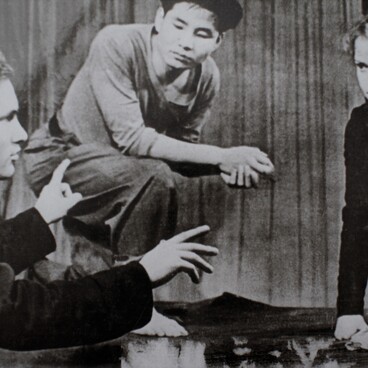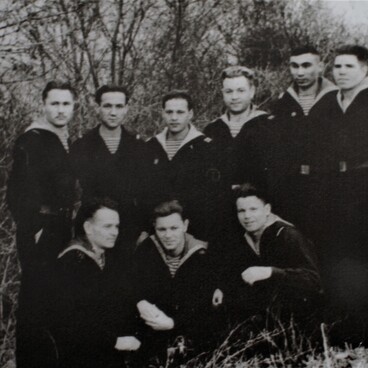Ivan Popov depicted his second cousin, Vasily Shukshin, in the centre of the picture. The background represents Shukshin’s native village Srostki in his favourite season, early spring, when everything in nature is just beginning to come to life after the frosts.
The artist managed to convey perfectly all of his cousin’s features: folds on the forehead, strong-willed cheekbones, and most importantly, somewhat sad and tired eyes. In the background, Popov placed the Shukshin family’s parental house, the office buildings of the Srostki government-owned farm, and the secondary school.
Popov was born in 1926 and lived a life typical of his time: a difficult childhood without a father followed by the death of his mother, a vocational school and work at a factory. However, the future painter managed to change his fate completely after World War II: he joined an art school in Kyiv and then graduated from an art college there. His teachers were the famous masters Alexei Shovkunenko and Tatyana Yablonskaya. Thanks to his diploma thesis “Sisters”, Popov became a candidate for membership in the Union of Soviet Artists.
After graduation, the artist spent several years in Donetsk. In 1959, he moved to Novosibirsk, where he lived and worked until 2007. The rural everyday life of working people was the main motive of Popov’s paintings throughout his life. This was how he got together with his mother’s relative, Shukshin. Both tried to convey the same thing to people, only in different ways: one through his paintings, the other through cinema and literature.
The two like-minded persons collaborated a lot: Popov was a crew member for all Shukshin’s films, he travelled to shooting locations, made sketches and helped to choose the sites in the Altai region during the shooting of Happy Go Lucky and There is Such a Lad. Later Shukshin’s life and work, as well as Srostki landscapes, took a major place in the artist’s pictures. In the 1990s, he created the series Memories of Vasily Shukshin in Drawings. At the end of his career, Popov wrote a memoir outlining details of his life and friendship with Shukshin.
The artist managed to convey perfectly all of his cousin’s features: folds on the forehead, strong-willed cheekbones, and most importantly, somewhat sad and tired eyes. In the background, Popov placed the Shukshin family’s parental house, the office buildings of the Srostki government-owned farm, and the secondary school.
Popov was born in 1926 and lived a life typical of his time: a difficult childhood without a father followed by the death of his mother, a vocational school and work at a factory. However, the future painter managed to change his fate completely after World War II: he joined an art school in Kyiv and then graduated from an art college there. His teachers were the famous masters Alexei Shovkunenko and Tatyana Yablonskaya. Thanks to his diploma thesis “Sisters”, Popov became a candidate for membership in the Union of Soviet Artists.
After graduation, the artist spent several years in Donetsk. In 1959, he moved to Novosibirsk, where he lived and worked until 2007. The rural everyday life of working people was the main motive of Popov’s paintings throughout his life. This was how he got together with his mother’s relative, Shukshin. Both tried to convey the same thing to people, only in different ways: one through his paintings, the other through cinema and literature.
The two like-minded persons collaborated a lot: Popov was a crew member for all Shukshin’s films, he travelled to shooting locations, made sketches and helped to choose the sites in the Altai region during the shooting of Happy Go Lucky and There is Such a Lad. Later Shukshin’s life and work, as well as Srostki landscapes, took a major place in the artist’s pictures. In the 1990s, he created the series Memories of Vasily Shukshin in Drawings. At the end of his career, Popov wrote a memoir outlining details of his life and friendship with Shukshin.

